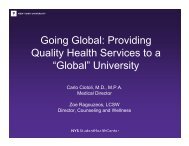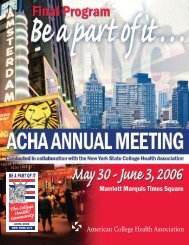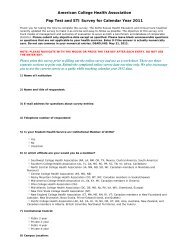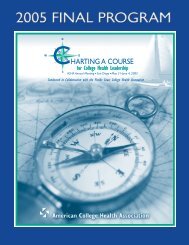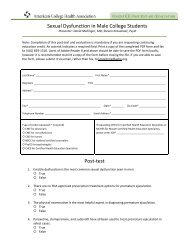Stimulant Misuse: Strategies to Manage a Growing Problem (.pdf)
Stimulant Misuse: Strategies to Manage a Growing Problem (.pdf)
Stimulant Misuse: Strategies to Manage a Growing Problem (.pdf)
- No tags were found...
Create successful ePaper yourself
Turn your PDF publications into a flip-book with our unique Google optimized e-Paper software.
USE AND MISUSE OF STIMULANTS<br />
Table 2. Reasons/Rationale Why Individuals <strong>Misuse</strong> Prescription <strong>Stimulant</strong>s<br />
• Achieve a euphoric state<br />
• Increase mental alertness<br />
• Increase energy level<br />
• Ease of obtaining these medications from peers or clinicians<br />
• Reduce the pressures of academic life<br />
• Seen as a part of a plan <strong>to</strong> improve poor grades<br />
• Unsolicited “gift” from other students (eg, for sex or friendship)<br />
• Belief that it is a safe practice<br />
• Selling these medications <strong>to</strong> make money<br />
• Consistent with a lifestyle of polypharmacy (illict and nonillicit)<br />
lege peers. 17 A 2001 study of 10,904 college students using selfreports<br />
identified a 6.9% lifetime prevalence of nonmedical<br />
prescription stimulant misuse, including a past-year prevalence<br />
of 4.1% and a past-month prevalence of 2.1%. 18 A recent study<br />
by Teter et al of 9161 undergraduates reported an 8.1% lifetime<br />
prescription stimulant abuse rate among college students,<br />
including 5.4% over the past year. 19 A smaller study found that<br />
out of 179 college males and 202 college females surveyed, 17%<br />
of males and 11% of females had engaged in illicit prescription<br />
stimulant misuse. 20 According <strong>to</strong> a 2002 survey of a single US<br />
college, 35.5% of undergraduates reported using stimulants<br />
without a prescription, with greater frequency occurring in<br />
males compared with females. 21<br />
Obtaining <strong>Stimulant</strong>s Through Illicit Means<br />
Amphetamine and methylphenidate products are acquired in a<br />
number of ways, such as from classmates, friends, clinicians, or<br />
through the Internet. School health officials should be aware<br />
that students misusing stimulant medications may employ various<br />
means <strong>to</strong> gain access <strong>to</strong> these medications, such as stealing<br />
pills from a teacher’s desk (when a teacher is chosen <strong>to</strong> dispense<br />
medication <strong>to</strong> students), making arrangements with or exerting<br />
pressure on a classmate who has a legitimately prescribed<br />
medication, or presenting symp<strong>to</strong>ms of ADHD at the college<br />
health center in an attempt <strong>to</strong> be prescribed a stimulant. 20,22 The<br />
DEA reported nearly 700,000 methylphenidate doses s<strong>to</strong>len in<br />
the United States in 1996 and 1997. 15<br />
The diversion of stimulants is very common and can begin in<br />
childhood, adolescence, or young adulthood. One survey<br />
reported that 23.3% of middle and high school students taking<br />
prescribed stimulants had been solicited <strong>to</strong> divert their medication<br />
<strong>to</strong> others at a rate that increased from middle school <strong>to</strong><br />
high school. 23 A review of 161 elementary and high school students<br />
prescribed the stimulant methylphenidate revealed that<br />
16% had been asked <strong>to</strong> give or sell their medication <strong>to</strong> others. 24<br />
A self-reported anonymous questionnaire administered <strong>to</strong> a<br />
random sample of Canadian students in grades 7, 9, 10, and 12<br />
found that of the 5.3% of students who had used a legitimately<br />
prescribed stimulant over the previous 12 months, 14.7%<br />
reported having given their medications <strong>to</strong> others, 7.3% had<br />
sold their medications <strong>to</strong> others, and 4.3% had their medications<br />
s<strong>to</strong>len. 25 Data have shown that the diversion continues<br />
among college students. 5,18 A recent survey of 334 college students<br />
who were prescribed stimulants for ADHD revealed that<br />
nearly 29% had sold or given their medication <strong>to</strong> others. 10<br />
Reasons for <strong>Misuse</strong><br />
The motives for misuse and abuse of stimulants are numerous<br />
(Table 2). Studies have shown that students with and without<br />
ADHD misuse these medications <strong>to</strong> achieve euphoria. 10,20<br />
According <strong>to</strong> a survey of 334 ADHD-diagnosed college students<br />
taking prescription stimulants, 25% misused their own<br />
prescription medications <strong>to</strong> get high. 10 Students may also use<br />
stimulants <strong>to</strong> help cope with stressful fac<strong>to</strong>rs related <strong>to</strong> their<br />
educational environment. Pressures such as a persistent desire<br />
<strong>to</strong> succeed academically, erratic and poor sleep habits due <strong>to</strong><br />
large workloads, and the persistence of underlying social and<br />
financial demands may place students at an increased risk for<br />
misuse of various drugs, including stimulants. 19,20,26 Students<br />
often assume these drugs are safe <strong>to</strong> use for improving their<br />
energy levels, increasing their capacity for concentration,<br />
enhancing school performance, or for recreational use, while<br />
lowering their desire for sleep. 26 <strong>Stimulant</strong>s are especially popular<br />
at the end of a school term when students will often use the<br />
drugs <strong>to</strong> stay awake through the night <strong>to</strong> study for exams or<br />
complete academic projects.<br />
Any type of student may misuse stimulants, but there may be<br />
an increased risk among students with low grade-point averages<br />
(or an average that falls below a student’s personal standards)<br />
or those at very competitive schools. 18 Athletes may see<br />
stimulants as a way <strong>to</strong> help maintain physical fitness for their<br />
competitive sport or <strong>to</strong> improve their concentration. 27 Men<br />
appear <strong>to</strong> be more likely than women <strong>to</strong> misuse these drugs,<br />
but both sexes show similar motives for drug misuse. 18,19<br />
Relationship of <strong>Stimulant</strong> Use <strong>to</strong> Substance <strong>Misuse</strong><br />
A frequent concern regarding the use of stimulant medications<br />
is that their mechanisms of action, which provoke<br />
ACHA PROFESSIONAL DEVELOPMENT PROGRAM 19



![Final Program [5.4MB pdf] - American College Health Association](https://img.yumpu.com/49022356/1/190x245/final-program-54mb-pdf-american-college-health-association.jpg?quality=85)


